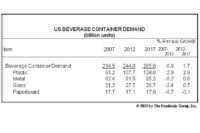Demand for beverage containers in China to exceed 469 billion units in 2015

Plastic beverage containers will continue to account for the largest share of total sales, reaching nearly 223 billion units in 2015 and reflecting their widespread use in the Chinese beverage industry. Demand will benefit from plastic containers’ low cost and expanding usage in almost every beverage market, as well as from technological improvements. Advances will also be driven by their advantages over other materials, including shatter resistance, light weight, ability to be produced in diverse sizes and shapes, and resealability. Moreover, single-serving plastic containers will continue to make inroads into the market, leading to increases in unit growth, as well as further declines in the average plastic container size.
Demand for glass bottles, the second largest container type, will increase 7% per year through 2015. Gains will continue to benefit from favorable trends in beer consumption and the expanding use of nonreturnable beer bottles. Opportunities will also be found where glass is valued for its premium image, quality and ability to differentiate new products. Healthy growth of glass bottle sales is also expected in the fruit beverage market.
Fast growth is expected for paperboard containers, as unit demand increases 11.1% annually through 2015. Opportunities for paperboard containers are expected in the packaging of milk, fruit beverages, and other nonalcoholic beverages. In particular, aseptic cartons will post strong growth, benefiting from their ability to provide lengthy shelf life at room temperature. Gains for metal cans will be close to the overall average growth for beverage containers.
Looking for a reprint of this article?
From high-res PDFs to custom plaques, order your copy today!





